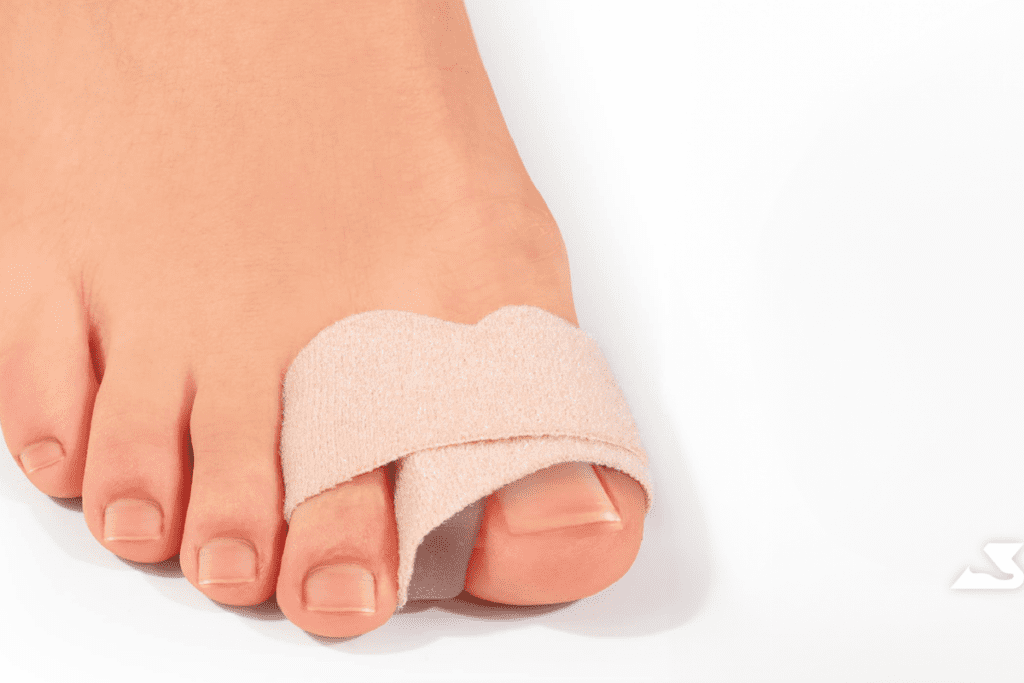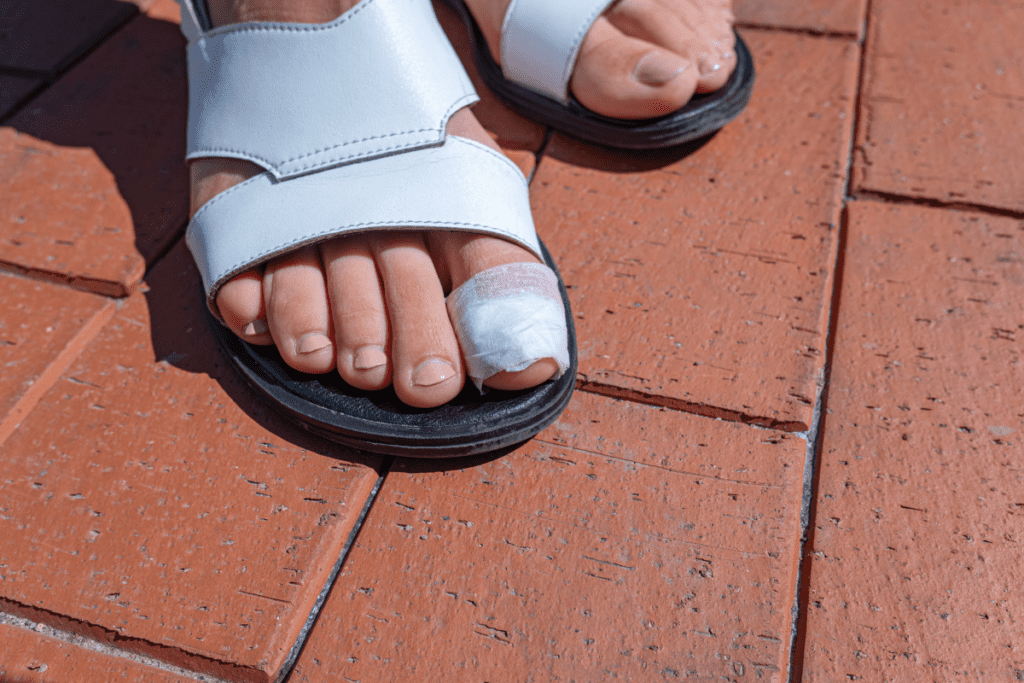This guide is for informational purposes only. Some services may not be offered in our offices. Your doctor will guide you through your treatment options during your appointment.
Taping a broken toe is a crucial step in promoting faster healing and relieving pain. Buddy taping, a widely-used technique, involves taping the injured toe to an adjacent healthy one, offering support and stability. This method ensures the broken bone stays immobile for proper healing.
In this guide, we’ll cover the essentials of when to tape a broken toe, the supplies you’ll need, how to do it, and essential post-taping care. By following these steps, you can facilitate a quicker recovery and avoid complications.
When to Consider Taping a Broken Toe
Taping a broken toe is most beneficial for minor fractures resulting from stubbing your toe or dropping something heavy on your foot. This method is ideal for stabilizing fractures in smaller toes like the pinky toe, though it can be used for any toe injury. The primary purpose of taping is to immobilize the bone, allowing it to heal properly.
Which Toes Are Best for Buddy Taping?
For buddy taping, the injured toe should be taped to the adjacent healthy toe. For instance, if your pinky toe is broken, it should be taped to the next toe. This method provides the necessary support to prevent movement and minimize pain.
When Not to Tape a Broken Toe
If the toe is severely dislocated, crooked, or if there’s an open wound, avoid taping it and seek medical care instead. Taping should not be done if the toe needs repositioning or if there are signs of a more serious injury.
How Taping Aids Healing
Taping helps by keeping the fractured toe in place, preventing it from moving, which is essential for proper recovery. This immobilization allows the bones to align and heal, reducing the risk of further injury.

Before starting the taping process, gather the following items:
Medical tape (skin-friendly, non-irritating)
Cotton or gauze padding (for comfort and protection)
Scissors (to cut the tape to size)
3pp Toe Loops (optional, provides additional protection)
Medical Tape: Why It’s Important
Medical tape is crucial because it is designed specifically for use on the skin. Unlike standard adhesive tapes, medical tape is gentle and won’t cause irritation, allowing it to be used safely for extended periods.
Gauze or Padding for Skin Protection
Padding between the toes prevents skin irritation or blisters caused by friction. Cotton gauze, foam, or a soft material can be placed between the injured and healthy toe for additional comfort.
Using 3pp Toe Loops as an Alternative
If you’re looking for a less traditional option, 3pp Toe Loops are great. They are easy to apply, comfortable, and reduce skin irritation while providing the necessary support for healing.
Preparing the Toe
Before taping, thoroughly clean the injured toe to prevent infection:
1. Clean the toe with soap and water.
2. If there are any cuts or abrasions, use an antiseptic wipe.
3. Dry the toe completely before starting the taping process, as moisture can affect the tape’s adhesion.
Applying Padding
1. Insert a small piece of cotton or gauze between the injured and adjacent healthy toe.
2. Ensure the padding is snug but not tight to prevent skin friction.
3. Proper padding helps maintain circulation while keeping the toes comfortable.
Taping the Toes Together
1. Gently place the injured toe next to the healthy toe.
2. Wrap the medical tape around both toes near the base. Be careful not to make the tape too tight, as it can cut off circulation.
3. Wrap the tape two to three times around the toes, ensuring the padding stays in place.
4. Make sure the toes are secured but can still move slightly, as too much restriction may cause discomfort.
Checking for Circulation
After taping, press on the tips of the toes to check for proper circulation. The toe should return to its normal color quickly. If not, adjust the tape to loosen it slightly.

Immediate Care After Taping
Once taped, it’s essential to take the following post-taping steps to ensure optimal recovery:
1. Ice the toe for 20 minutes every hour for the first 24 hours to reduce swelling.
2. Elevate the foot above heart level to decrease swelling and pain.
3. **Limit weight-bearing activities** to avoid stressing the broken toe.
Managing Pain and Swelling
Over-the-counter pain medications like ibuprofen or acetaminophen can be helpful in managing pain and inflammation. Avoid using heat packs, as they can worsen swelling in the initial stages of recovery.
Avoid Common Mistakes
1. Do not tape too tightly—ensure proper blood circulation.
2. Never tape directly on skin—always use padding to prevent blisters.
3. Monitor the injury—look for signs of infection such as redness, warmth, or discharge.
When to Seek Medical Help
If symptoms worsen or the toe appears crooked, seek medical attention. Other warning signs include fever, chills, red streaks on the toe, or numbness in the injured area.
Choosing the Right Footwear for Recovery
During the healing process, wear stiff-soled shoes that protect the toe from unnecessary movement. Special post-op shoes or walking boots can also help provide extra support.
The information on our website is intended for general informational and educational purposes only and should not be used as a substitute for professional medical advice. For any health-related concerns, we strongly recommend consulting with a healthcare professional. Please note that any reliance on the information found on our site is solely at your own risk. For more details, please see our Medical Disclaimer.
Modern Foot & Ankle offers expert foot and ankle care, conveniently located in your Florida or Texas community. Our multiple locations offer a wide network of the best podiatrists, skillfully trained to meet your specific needs. Our nationally recognized physicians and surgeons cover the full spectrum of foot and ankle concerns, including complex lower extremity conditions. Our foot and ankle doctors combine advanced technology with patient-centric care to deliver treatment plans to get you back on your feet, often right inside your neighborhood.
Browse our extensive network of offices across Florida and Texas, and experience the best foot and ankle care at your nearest local Modern Foot & Ankle location.
Stay informed by reviewing some of our patients frequently asked questions about what to expect when visiting one of our Florida or Texas foot and ankle care offices. Contact the office directly if you need further assistance. We’re here to help!
Modern Foot & Ankle offers a wide range of podiatry services including foot and ankle surgery, sports medicine, pediatric foot care, wound care, orthotics, and more. They also provide specialized treatments for conditions such as bunions, hammertoes, heel pain, and ingrown toenails among others.
To schedule an appointment, you can call the clinic directly or fill out the appointment request form available on their website. They have multiple locations, so you can choose the one that’s most convenient for you.
During your first visit, the podiatrist will conduct a thorough examination, discuss your medical history, and address any concerns or symptoms you may have. They will then develop a personalized treatment plan based on your specific needs.
Yes, the podiatrists at Modern Foot & Ankle are skilled in performing a variety of foot and ankle surgeries. These include procedures for bunions, hammertoes, fractures, and more. They utilize the latest techniques and technology to ensure the best possible outcomes for their patients.
Modern Foot & Ankle is committed to providing comprehensive, high-quality podiatric care. They believe in a patient-centered approach, where the focus is on educating patients about their condition and treatment options, enabling them to make informed decisions about their care.
Modern Foot & Ankle accepts a variety of insurance plans. It’s recommended to check with the clinic directly or with your insurance provider to confirm coverage before scheduling an appointment.

